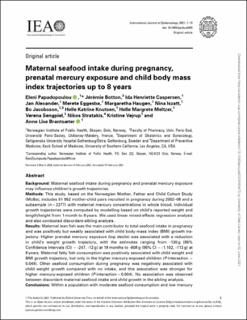Maternal seafood intake during pregnancy, prenatal mercury exposure and child body mass index trajectories up to 8 years
Papadopoulou, Eleni Zoumpoulia; Botton, Jérémie; Caspersen, Ida Henriette; Alexander, Jan; Eggesbø, Merete Åse; Haugen, Margaretha; Iszatt, Nina; Jacobsson, Bo; Knutsen, Helle Katrine; Meltzer, Helle Margrete; Sengpiel, Verena; Stratakis, Nikos; Vejrup, Kristine; Brantsæter, Anne Lise
Peer reviewed, Journal article
Published version
Permanent lenke
https://hdl.handle.net/11250/2757599Utgivelsesdato
2021Metadata
Vis full innførselSamlinger
- Artikler [5068]
- Publikasjoner fra CRIStin FHI [7544]
Sammendrag
Background:Maternal seafood intake during pregnancy and prenatal mercury exposuremay influence children’s growth trajectories.Methods:This study, based on the Norwegian Mother, Father and Child Cohort Study(MoBa), includes 51 952 mother-child pairs recruited in pregnancy during 2002–08 and asubsample (n¼2277) with maternal mercury concentrations in whole blood. Individualgrowth trajectories were computed by modelling based on child’s reported weight andlength/height from 1 month to 8 years. We used linear mixed-effects regression analysisand also conducted discordant-sibling analysis.Results:Maternal lean fish was the main contributor to total seafood intake in pregnancyand was positively but weakly associated with child body mass index (BMI) growth tra-jectory. Higher prenatal mercury exposure (top decile) was associated with a reductionin child’s weight growth trajectory, with the estimates ranging from -130 g [95%Confidence Intervals (CI)¼-247, -12 g] at 18 months to -608g (95% CI¼-1.102, -113 g) at8 years. Maternal fatty fish consumption was positively associated with child weight andBMI growth trajectory, but only in the higher mercury-exposed children (P-interaction¼0.045). Other seafood consumption during pregnancy was negatively associated withchild weight growth compared with no intake, and this association was stronger forhigher mercury-exposed children (P-interaction¼0.004). No association was observedbetween discordant maternal seafood intake and child growth in the sibling analysis.Conclusions:Within a population with moderate seafood consumption and low mercury exposure, we found that maternal seafood consumption in pregnancy was associatedwith child growth trajectories, and the direction of the association varied by seafood typeand level of prenatal mercury exposure. Prenatal mercury exposure was negatively asso-ciated with child growth. Our findings on maternal seafood intake are likely non-causal.
